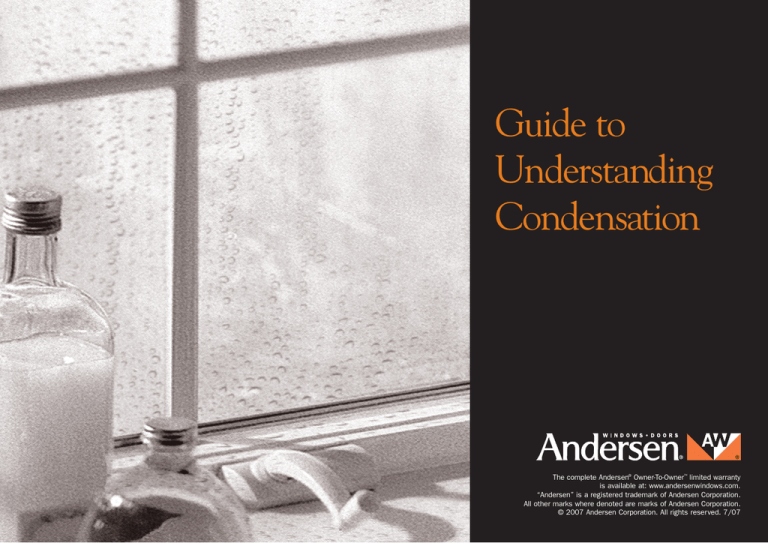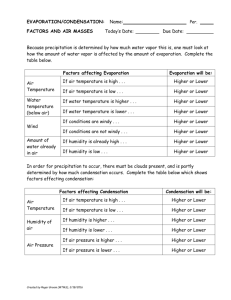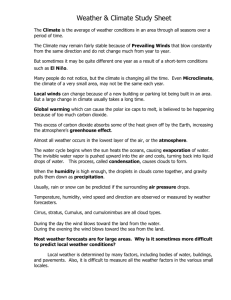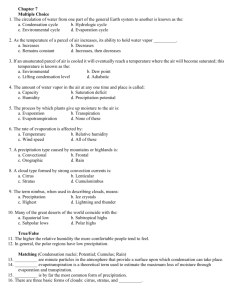
Guide to
Understanding
Condensation
The complete Andersen® Owner-To-Owner™ limited warranty
is available at: www.andersenwindows.com.
“Andersen” is a registered trademark of Andersen Corporation.
All other marks where denoted are marks of Andersen Corporation.
© 2007 Andersen Corporation. All rights reserved. 7/07
INTRODUCTION
2
The moisture that suddenly appears in cold weather on the interior
or exterior of window and patio door glass can block the view, drip
on the floor or freeze on the glass. It can be an annoying problem.
While it may seem natural to blame the windows or doors, interior
condensation is really an indication of excess humidity in the home.
Exterior condensation, on the other hand, is a form of dew — the
glass simply provides a surface on which the moisture can condense.
We have created this brochure to answer questions you may have
about condensation, indoor humidity and exterior condensation.
We’ll start with the basics and offer solutions and alternatives
along the way.
The important thing to realize is that if excessive humidity is
causing window condensation, it may also be causing problems
elsewhere in your home. Here are some other signs of excess
humidity:
Visit the Andersen website: www.andersenwindows.com
•
•
•
•
•
•
A “damp feeling” in the home.
Staining or discoloration of interior surfaces.
Mold or mildew on surfaces or a “musty smell.”
Warped wooden surfaces.
Cracking, peeling or blistering interior or exterior paint.
Sweating pipes.
Should you run into problems or situations not covered in the
following pages, please contact your Andersen retailer.
The Andersen customer service toll-free number: 1-888-888-7020.
CONDENSATION
AND
3
HUMIDITY
What is condensation?
Moisture on the windows is a form of condensation. So is the water that forms
on the outside of a glass of iced tea in the summer. It comes from water vapor
in the air. It can appear on the interior or exterior of the window glass.
What causes condensation?
What is relative humidity?
When warm, moist air comes into contact with cooler surfaces, the excess
moisture in the air condenses. That’s because the cooled air next to the cool
surface can’t hold as much moisture as the warmer surrounding air.
Air can hold only a limited amount of water vapor, and that amount depends
on the air temperature. When air at a certain temperature contains all the vapor
it can hold, it’s said to have a relative humidity of 100%. Thus, when
it holds only half as much water as it could, the relative humidity is 50%.
What does the condensation on windows mean?
Window condensation can be a warning sign. It may mean that excessive indoor
humidity could be doing unseen damage to other parts of your home.
What is humidity?
Humidity is water vapor, or moisture, in the air. Usually it’s invisible. In the form
of steam or ground fog, enough has condensed to be seen. All air contains a
certain amount of moisture, visible or not.
Where does indoor moisture come from?
There are many things that generate indoor moisture. The normal perspiration and
breathing of a family of four adds about half a pint of water to the air every hour. Cooking
three meals a day adds four or five pints of water to the air. Each shower contributes
another half-pint. In fact, every activity that uses water (like dishwashing, mopping floors,
doing laundry) adds moisture to the air. Daily living activities of a family of four can add
more than 18 gallons of water a week to the air in their home. And the more water vapor
in the air, the higher the relative indoor humidity. Other contributors include house plants,
and the burning of fossil fuels (especially kerosene, natural gas, and oil).
Cooler air can hold less vapor than warmer air. So air at 30°F and 100%
relative humidity contains less water than air at 70°F and 100% relative humidity.
How do I measure indoor relative humidity?
You can use humidity-measuring instruments called hygrometers, inexpensive
tools that can be purchased at most hardware stores. Many of today’s new
programmable thermostats also include controls for humidifiers and dehumidifiers.
Remember that relative humidity levels quoted in weather reports indicate
outdoor humidity. They have little bearing on your home’s humidity.
What are symptoms of excess humidity?
Condensation on windows can sometimes be an indicator of excessive relative
humidity. Look for water and ice on windows. Check for damp spots on the
ceiling, particularly in closets. Water-filled blisters on outside paint surfaces
can also indicate excessive indoor humidity.
CONDENSATION
(CONTINUED)
AND
HUMIDITY
4
Can relative humidity affect my health?
Does condensation occur only in winter?
Most experts agree that relative humidity can affect your health. They suggest
maintaining indoor humidity levels between 30% and 50%. According to the
World Health Organization, at levels higher than 65%, upper respiratory illness
might occur in people suffering from asthma and allergies. Lower moisture
levels (below 20%) may induce skin dryness or itching.
Condensation is most common in winter, but it can occur whenever water
vapor in the air comes in contact with a surface temperature lower than the
dew point (the temperature at which air becomes saturated and produces dew).
For example, on cold winter days the moisture in the warm, interior air can
condense on the typically colder glass surfaces.
Where is condensation most prevalent?
In rare instances, during the spring and fall (and occasionally, during hot, humid
summer days), exterior condensation can also form on windows. This is usually
a good indicator of the presence of energy efficient windows.
Condensation is more apt to occur in climates where the average January
temperature is 35°F or colder.
What does excess humidity do to my home?
Excess humidity contributes to the deterioration of any home. It can pass through
walls and freeze in the insulation. In spring it melts, damaging your ceiling and
walls. Or, excess humidity can force its way out through siding to form blisters
under exterior surfaces. Excessive relative humidity levels may also lead to higher
levels of unwanted mold and mildew growth in homes.
How does moisture go through walls?
Moisture in wet air tries to flow toward dry air. This is due to “vapor pressure.”
The flow acts independently of air currents. In winter, inside air is much more
humid than colder outside air. So the vapor pressure, or equalization process,
can actually force inside moisture through cement, wood, plaster and brick.
Some varnishes and paints block the flow of the moisture, so condensation can
occur between the inside and outside walls, or under exterior paint surfaces.
This can cause rot in a home’s wood frame, blistering in paint, and deterioration
of other building materials.
Does the severity of the condensation
depend on the age of the house?
Generally, yes. Years ago, before energy efficiency became a concern, homes
were not built to be weathertight. Insulation concepts were very basic. Walls and
ceilings were made from much more porous materials. Thus, water vapor could
easily flow in and out of walls. Today’s homes are much “tighter.” Windows and
doors are built to reduce air leakage, and weatherstripping, modern insulation,
vapor barriers and new construction techniques can help keep cold air out and
lock moisture inside. As a result, moisture created by bathrooms, kitchens,
laundries, plants and occupants can result in higher interior relative humidity. In
the worst conditions this can build up to excessive, even harmful, moisture levels.
COMFORT
AND INDOOR
HUMIDITY
What is the relationship between
humidity and comfort?
Whether or not you feel comfortable in a room is dependent on many factors,
including the temperature of the air, the relative humidity, the movement of
the air, the temperature of all of the surrounding surfaces in the room, and
the presence of direct solar radiation. Since indoor humidity is one critical
component of comfort, you should carefully consider the indoor humidity
conditions in both summer and winter.
Humidity and winter comfort
Higher humidity levels in a home might mean greater comfort in the winter. Some
people find it easier to breathe humidified air. Soft tissues such as the linings of
your nose and throat don’t dry out as easily, and, in some cases, the dry winter air
might even need to be humidified to help achieve good thermal comfort in winter.
Most people will be comfortable in the winter if the indoor relative humidity is
between 25% and 60% and the indoor temperature is between 65°F and 70°F.
Humidity and summer comfort
Almost everyone has experienced the discomfort associated with high temperatures
combined with high humidity. In fact, one of the key advantages of air conditioning
is the removal of unwanted moisture in the air during the summer.
Again, many elements contribute to summertime comfort — air temperature, surface
temperatures, relative humidity, air movement, and direct solar radiation.
Most people will feel comfortable in the summer if the indoor relative humidity is
between 25% and 60% and the indoor temperature is between 72° and 82° F.
5
CONTROLLING INDOOR HUMIDITY
How does indoor humidity affect window condensation?
Excessive humidity is the cause of most window condensation. As the outside
temperature drops, the window glass temperature also drops. When moist air
comes in contact with the cold glass pane, the moisture condenses and forms
water droplets. Determining when the condensation will occur and preventing it
depends on the energy efficiency of the window, the relative indoor humidity of
the home, and the exterior and interior temperature.
In winter, is it a good idea to use a
humidifier in my home?
While some people may find it easier to breathe humidified air, humidification can
sometimes have negative side effects. Humidifiers need to be cleaned regularly. If
not, molds and bacteria can live in them. Also, if the air is humidified excessively,
condensation and other excess humidity-related problems can occur.
On the plus side, humidified air can help to reduce static electricity in carpets,
shrinkage in wood furniture, and wall cracks sometimes caused by over-drying.
You must carefully weigh the advantages and disadvantages of humidification.
Remember, too much humidity can cause condensation and other moisturerelated problems.
6
If I increase the relative humidity in my home in winter,
can I lower the temperature and save energy?
Although there is a relationship between how warm you feel and relative humidity, the
human body quickly adjusts to moderate changes in humidity levels. If you feel cold at
65°F, the humidity level really won’t matter. You’ll still feel cold.
Besides turning off the humidifier, how else can I reduce indoor humidity in winter?
● Vent all gas appliances, clothes dryers and exhaust fans to the outside. Your attic
and crawl space should also be ventilated. Cover the earth in the crawl space with
a good vapor barrier.
●
When you cook, make sure to run the exhaust fans in the kitchen. When you
bathe or shower, run the fans in the bathroom until your mirror is clear. Be careful
not to overheat exhaust fans by running them too long.
●
Avoid storing firewood in your house or basement.
●
If you have a forced air furnace, make sure your home is properly ventilated by
installing a fresh air intake. If your home is extremely “tight”, it may be helpful
to install an air-to-air heat exchanger.
As the outside air temperature drops, you should also decrease the humidity level
within your home. The bottom line: maintain as high a relative humidity level as you
can for comfort, then reduce the humidity level when condensation occurs. In many
homes this simply means turning off the humidifier, or reducing the sources of
humidity in the home.
WINDOWS
AND
CONDENSATION
7
Does the amount of condensation
depend on the window type?
What causes condensation on the
inner surface of storm windows?
Bay or bow windows usually experience more condensation than other window
styles. This is because inside air circulation around these window styles is usually
more restricted. And, since they hang away from the insulated house wall, bays
and bows are usually a few degrees cooler in temperature. To help control
excessive condensation, it’s smart to insulate between the window head and
platform. In extremely cold climates, additional insulation above and below the
window platform may be needed. As a secondary measure, placing a common
electric fan near the window helps promote air circulation and can reduce
window condensation.
All operating windows leak some air between the window frame and sash. So
when warm household air seeps in around the sash and becomes trapped by the
colder storm window, condensation forms on the inside surface. Providing outside
ventilation to the combination storm window can usually reduce condensation
buildup.
How do drapes and window shades
affect window condensation?
Drapes and other window coverings can contribute to a condensation problem
by restricting the flow of warm room air over the glass surface. Therefore, indoor
condensation is more apt to occur when the drapes are closed or the shades
are pulled down.
What causes moisture to form on
the outside of the windows?
It’s dew, the same condensation you see on windshields, lawns and streets on
many mornings. Condensation like this happens only when the exterior surface
temperature of the glass falls below the dew point of the air. When humidity
levels are higher, this kind of condensation is more likely to form. Most of the
time, exterior window condensation takes place in the Spring and Fall, when
cool nights follow warm days.
Can excess condensation damage windows?
Why does a 1"-wide strip of condensation sometimes
form all the way around the window?
Excess window condensation can cause paint to peel from the sash. Excess moisture
can also damage the window frame.
If a strip of condensation forms all the way around the window, chances are good
that the unit features metal components that are transmitting cold from the outside
to the inner glass, cooling the glass surface where the condensation forms. In effect,
the center of the glass stays warmer than the glass close to the edge. This strip of
condensation doesn’t mean the window is leaking air or not working properly.
Is exterior condensation anything to worry about?
Dew on windows is a natural atmospheric phenomenon, and it doesn’t mean your
windows are leaking air or malfunctioning in any way. In fact, exterior condensation
is a sign of energy efficiency, since it means the outside pane is thoroughly
insulated from the heat indoors. Depending on where you live, it may occur just
a handful of times per season.
WINDOWS AND CONDENSATION
(CONTINUED)
Are there any cases where window
condensation is only temporary?
There are primarily three causes for temporary window condensation.
New Construction: Wood, plaster, cement and other building materials used
in new construction and remodeling produce a great deal of moisture. When
the heating season starts, this moisture will gradually flow out into the air in
the home. It will usually disappear during the first heating season and not
cause any further trouble.
Heating Season: At the beginning of the heating season, there may be a certain
amount of temporary condensation. During the humid summer months, your
house can absorb some moisture. After the first few weeks of heating, this
moisture should dissipate.
Preceding Temperature Shifts: Sharp, quick drops in temperature can also
create temporary condensation problems during the heating season.
8
Maximum Recommended Humidity Levels
Outside Air Temperature
Inside Relative Humidity
-20° F or Below
Not over 15%
-20° F to -10° F
Not over 20%
-10° F to 0° F
Not over 25%
0° F to 10° F
Not over 30%
10° F to 20° F
Not over 35%
20° F to 40° F
Not over 40%
• Based on engineering studies at 70° F conducted
at the University of Minnesota Laboratories.
• Relative humidity levels above these are not recommended at the low
outside temperatures indicated, unless special provisions are taken in
building construction.
• If higher relative humidity levels are required because of special interior
environmental conditions, the window manufacturer should be consulted.
ANDERSEN HIGH-PERFORMANCE LOW-E4 GLASS
®
™
™
®
How does the coating on Andersen High-Performance™
Low-E4™ glass affect room temperature?
It works through a special metallic coating bonded to the interior surface of the
outside pane of glass. It’s almost invisible, but this revolutionary coating actually
detects radiant heat and restricts its flow through the glass. During cold weather,
High-Performance™ Low-E4™ glass helps keep heat inside. In warm weather it helps
keep heat outside.
®
What is the difference between Andersen
High-Performance Low-E4 & High-Performance
Low-E4 Sun glass?
Andersen High-Performance Low-E4 glass is generally used in climates with
harsh winters. In the heating months, it is 35% more energy efficient than
ordinary dual-pane insulating glass. In the cooling months, Andersen HighPerformance Low-E4 glass is 41% more energy efficient than ordinary dual-pane
glass. High-Performance Low-E4 Sun glass, on the other hand, is specifically
designed for hotter climates or homes with a full western or southern exposure.
For more information on window condensation, contact an Andersen representative
and ask for a copy of the “Controlling Indoor Condensation” DVD. The Andersen
customer service toll-free number is 1-888-888-7020.
9
SOURCES
10
In order to provide accurate information in this booklet, we used the following sources:
ASHRAE Handbook of Fundamentals 1999
ASHRAE
[American Society of Heating,
Refrigerating and Air-Conditioning Engineers, Inc.]
1791 Tullie Circle, NE
Atlanta, GA 30329
www.ashrae.org
Builders Guide
Energy & Environmental Bldg. Assoc. [EEBA]
6520 Edenvale Boulevard
Suite 112
Eden Prairie, MN 55346
www.eeba.org
Building Science Consulting
70 Main Street
Westford, MA 01886
www.buildingscience.com
Cold Climate Housing Center
University of Minnesota
203 Kaufert Laboratory
2004 Folwell Avenue
St. Paul, MN 55108
EWC [Efficient Windows Collaborative]
Alliance to Save Energy
1850 M Street NW, Suite 600
Washington, DC 20036
www.efficientwindows.org
Energy Star® Programs
United States DOE & EPA
www.energystar.gov
Environmental Health and Engineering
60 Wells Avenue
Newton, MA 02459-3210
Residential Windows — A Guide to New Technologies
and Energy Performance Edition #1 & 2
Carmody, et al
Glass Products for Windows & Doors
Cardinal IG
12301 Whitewater Drive
Minnetonka, MN 55343
Seacor Environmental Engineering
3433 Broadway St. NE, Suite 150
Minneapolis, MN 55413
How to Save Money by Insulating Your Home
Federal Energy Administration
c/o Department of Energy
James Forrestal Building
1000 Independence Avenue Southwest
Washington, DC 20585
Michaud, Cooley, Erickson & Associates, Inc.,
Consulting Engineers
333 S. 7th St., Suite 1200
Minneapolis, MN 55402
Moisture Condensation
(University of Illinois
Building Research Council Circular F6.2)
University of Illinois at Urbana-Champaign
Building Research Council
One East St. Mary’s Road
Champaign, IL 61820
NFRC [National Fenestration Rating Council]
8484 Georgia Avenue, Suite 20
Silver Spring, MD 20910
www.nfrc.org
University of Minnesota
Department of Environmental Health and Safety
410 Church St. SE
Minneapolis, MN 55455
www.dehs.umn.edu
Window & Door Manufacturers Association (WDMA)
1400 East Touhy Ave., Ste 470
Des Plaines, IL 60018
www.wdma.com






